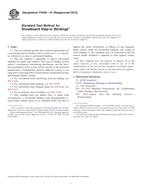Potřebujeme váš souhlas k využití jednotlivých dat, aby se vám mimo jiné mohly ukazovat informace týkající se vašich zájmů. Souhlas udělíte kliknutím na tlačítko „OK“.
ASTM F2546-07(2012)
Standard Test Method for Snowboard Step-in Bindings
Automaticky přeložený název:
Standardní zkušební metoda pro snowboard Step-in vázání
NORMA vydána dne 1.6.2012
Informace o normě:
Označení normy: ASTM F2546-07(2012)
Poznámka: NEPLATNÁ
Datum vydání normy: 1.6.2012
Kód zboží: NS-54103
Počet stran: 4
Přibližná hmotnost: 12 g (0.03 liber)
Země: Americká technická norma
Kategorie: Technické normy ASTM
Kategorie - podobné normy:
Anotace textu normy ASTM F2546-07(2012) :
Keywords:
ICS Number Code 97.220.20 (Winter sports equipment)
Doplňující informace
| Significance and Use | |||||||||||||||||||||
|
This test method describes the steps required to evaluate a step-in snowboard binding system function. The test method consists of a series of laboratory tests that evaluate resistance to static and dynamic loading, function under cold and icy conditions, impact and fatigue behavior and assessment of potential false positive release. All tests must be passed. All possible strains on the boot can be attributed to one torque M and one force F each on every axis X, Y, Z of a system of coordinates (see Fig. 1). The point of origin of the coordinates is agreed to be in the center of the ankle joint which is located approximately 100 mm from the plantar surface and 80 mm from the back of the heel. The torques and forces illustrated in the drawing in Fig. 1 are positive. The corresponding parameters acting in opposite direction are given negative signs. The arrowheads indicate the sense of rotation of the snowboard boot movement.
|
|||||||||||||||||||||
| 1. Scope | |||||||||||||||||||||
|
1.1 This test method specifies the essential requirements for a snowboard step-in bindingboot system (see 3.1.2); hereafter referred to as step-in snowboard bindings. 1.2 This test method is applicable to step-in snowboard bindings for adults and children. This type of binding system utilizes a mechanical interlocking mechanism, and the interlock mechanism of the system will be specific to the particular manufacturer. Compatibility between different systems is not expected or anticipated thus each potential combination of boot and binding requires testing. 1.3 For snowboard boots interfacing with ski binding, see ISO 11634. 1.4 For snowboard plate bindings, see ISO 14790. 1.5 For snowboard strap bindings made for soft boots, see ISO 14573. 1.6 For snowboard step-in bindings, see ISO 15344. 1.7 This standard does not address how or under what circumstances a snowboard binding with programmable release modes should release in its intended modes nor does it address the safety, desirability, or efficacy of any programmable release mode for snowboard bindings; any testing of such bindings to this standard must be performed with the release modes disabled or adjusted to their highest release value. 1.8 This standard does not purport to address all of the safety concerns, if any, associated with its use. It is the responsibility of the user of this standard to establish appropriate safety and health practices and determine the applicability of regulatory limitations prior to use. |
|||||||||||||||||||||
| 2. Referenced Documents | |||||||||||||||||||||
|
Podobné normy:
Historická
1.7.2013
Historická
1.7.2013
Historická
1.7.2014
Historická
1.6.2011
Historická
1.9.2010
Historická
1.12.2012
Doporučujeme:
Aktualizace zákonů
Chcete mít jistotu o platnosti užívaných předpisů?
Nabízíme Vám řešení, abyste mohli používat stále platné (aktuální) legislativní předpisy.
Chcete vědět více informací? Podívejte se na tuto stránku.



 ASTM F1061-08(2013)..
ASTM F1061-08(2013).. ASTM F1062-97(2013)..
ASTM F1062-97(2013).. ASTM F1063-09(2014)..
ASTM F1063-09(2014).. ASTM F1064-11
ASTM F1064-11 ASTM F1107-04(2010)..
ASTM F1107-04(2010).. ASTM F1587-12a
ASTM F1587-12a
 Cookies
Cookies
